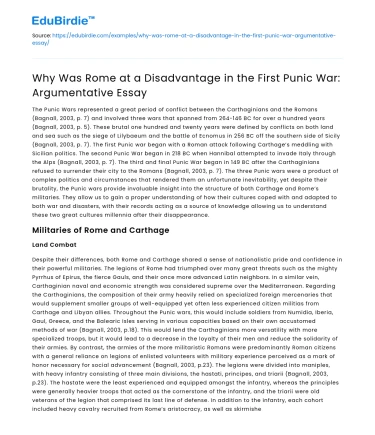The Punic Wars represented a great period of conflict between the Carthaginians and the Romans (Bagnall, 2003, p. 7) and involved three wars that spanned from 264-146 BC for over a hundred years (Bagnall, 2003, p. 5). These brutal one hundred and twenty years were defined by conflicts on both land and sea such as the siege of Lilybaeum and the battle of Ecnomus in 256 BC off the southern side of Sicily (Bagnall, 2003, p. 7). The first Punic war began with a Roman attack following Carthage’s meddling with Sicilian politics. The second Punic War began in 218 BC when Hannibal attempted to invade Italy through the Alps (Bagnall, 2003, p. 7). The third and final Punic War began in 149 BC after the Carthaginians refused to surrender their city to the Romans (Bagnall, 2003, p. 7). The three Punic wars were a product of complex politics and circumstances that rendered them an unfortunate inevitability, yet despite their brutality, the Punic wars provide invaluable insight into the structure of both Carthage and Rome’s militaries. They allow us to gain a proper understanding of how their cultures coped with and adapted to both war and disasters, with their records acting as a source of knowledge allowing us to understand these two great cultures millennia after their disappearance.
Militaries of Rome and Carthage
Land Combat
Despite their differences, both Rome and Carthage shared a sense of nationalistic pride and confidence in their powerful militaries. The legions of Rome had triumphed over many great threats such as the mighty Pyrrhus of Epirus, the fierce Gauls, and their once more advanced Latin neighbors. In a similar vein, Carthaginian naval and economic strength was considered supreme over the Mediterranean. Regarding the Carthaginians, the composition of their army heavily relied on specialized foreign mercenaries that would supplement smaller groups of well-equipped yet often less experienced citizen militias from Carthage and Libyan allies. Throughout the Punic wars, this would include soldiers from Numidia, Iberia, Gaul, Greece, and the Balearic Isles serving in various capacities based on their own accustomed methods of war (Bagnall, 2003, p.18). This would lend the Carthaginians more versatility with more specialized troops, but it would lead to a decrease in the loyalty of their men and reduce the solidarity of their armies. By contrast, the armies of the more militaristic Romans were predominantly Roman citizens with a general reliance on legions of enlisted volunteers with military experience perceived as a mark of honor necessary for social advancement (Bagnall, 2003, p.23). The legions were divided into maniples, with heavy infantry consisting of three main divisions, the hastati, principes, and triarii (Bagnall, 2003, p.23). The hastate were the least experienced and equipped amongst the infantry, whereas the principles were generally heavier troops that acted as the cornerstone of the infantry, and the triarii were old veterans of the legion that comprised its last line of defense. In addition to the infantry, each cohort included heavy cavalry recruited from Rome’s aristocracy, as well as skirmishers armed with javelins which were recruited from the legion’s youngest candidates (Bagnall, 2003, p.23). Each cohort was organized with gaps between its infantry files forming a formation that enabled units to rotate their positions, reinforce gaps, or retreat more easily. Rome also levied its allies, who were organized, and trained in the manner of Rome’s legions and deployed in their own maniples. The allied contingents would often form as much as half a Roman army.
Save your time!
We can take care of your essay
- Proper editing and formatting
- Free revision, title page, and bibliography
- Flexible prices and money-back guarantee
Naval Combat
Regarding their navies, the Carthaginians initially held a clear advantage as their reliance on maritime trade ensured naval dominance, and hence investment into its navy was always among its main ambitions. Their navy consisted of large cargo vessels, warships, and smaller vessels all built for speed and mobility. The Roman navy heavily relied on triremes and quinqueremes, though they were generally smaller and of inferior quality.
First Punic War
Rome’s opportunity to obtain the casus belli they desired came from a request by a Latin band of mercenaries known as the Mamertines. The Mamertines seized control of Messana and imposed their harsh rule on both the city and surrounding territories. To avoid conquest, the Mamertines sought an alliance with the Carthaginians but would betray them and successfully persuade the Romans to fight them. (Bagnall, 2003, p. 32). The conflict began with the Romans securing their dominance over Sicily with the seizure of Messana and the eventual withdrawal of Carthaginian forces. Despite their successes, the Romans remained unsatisfied and wished to completely eradicate Carthage’s influence in Sicily. This was difficult due to the might of Carthage’s navy and the strength of its Sicilian strongholds such as Lilybaeum (Bagnall, 2003, p. 36). These difficulties lead the Romans to force previously avoided confrontations with the Carthaginian navy, which culminated in several costly Roman victories, including the famed battle of Ecnomus. The battle of Ecnomus was decided by Roman ramming and boarding tactics, which crippled Carthage’s navy and allowed Rome to launch a short invasion of Africa itself (Bagnall, 2003, pp. 38-39). Despite Rome continuing to maintain an advantage, the remaining years of the conflict were largely inconclusive. The fatigue the costly war caused led the Carthaginians to eventually surrender to the Romans, who in exchange for peace levied a large war.






 Stuck on your essay?
Stuck on your essay?

